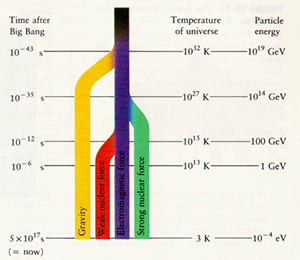The exploration of profound cosmic truths has intrigued humanity for millennia, and the quest for a Grand Unified Theory (GUT) reflects this eternal pursuit of knowledge. In the context of Bahá’í teachings, this notion provides a unique lens through which to view the interconnectedness of existence, ultimately promoting a paradigm shift in how we understand the universe and our place within it.
At its core, the Grand Unified Theory seeks to reconcile the seemingly disparate forces that govern the cosmos—specifically the strong nuclear force, weak nuclear force, electromagnetism, and gravity. This scientific endeavor not only seeks to unify these fundamental interactions but also demonstrates a profound metaphysical inquiry into the essence of reality. Mirroring the essence of the Bahá’í Faith, this quest embodies the principles of unity and interrelation that are foundational to Bahá’í thought.
Bahá’u’lláh, the founder of the Bahá’í Faith, elucidates a comprehensive worldview characterized by the oneness of humanity and the interconnectedness of all things. The GUT in this spiritual context does not merely pertain to physical phenomena but extends to the realms of ethics, society, and spirituality. The Bahá’í teachings posit that just as the forces of nature can be synthesized, so too can the myriad beliefs and cultures of humanity amalgamate into a singular tapestry of spiritual truth. This holistic perspective invites us to consider how we might harmonize our physical understanding of the universe with our spiritual insights.
Moreover, the core principle of the oneness of humanity illuminates the Bahá’í perspective on scientific advancement. The quest for a GUT serves as a microcosm for the broader objective of human harmony. Just as physicists endeavor to unify disparate forces, Bahá’ís are called to unify disparate peoples and cultures. This analogy serves to pique curiosity and beckons individuals to expand their cognitive frameworks by recognizing the parallels between scientific and spiritual quests for understanding.
Another essential facet of the Bahá’í interpretation of unity encompasses the concept of progressive revelation. This belief posits that divine guidance is revealed progressively over time through various Manifestations of God, such as Moses, Jesus, Muhammad, and Bahá’u’lláh. Each manifestation presents insights that are crucial for the evolution of human understanding. When viewed through the lens of a Grand Unified Theory, this concept might suggest that just as scientific theories evolve and adapt, so too does humanity’s comprehension of spiritual truths. Each divine message builds upon the last, moving toward a more consolidated vision of reality that embraces diversity within unity.
The Bahá’í teachings also stress the importance of the individual as both a microcosm of society and as a contributor to the collective knowledge pool. The idea that individuals can contribute to the Grand Unified Theory of existence fosters an environment of creativity and innovation. The dynamics of collaboration amongst diverse thinkers engenders a fertile ground for new ideas that resonate with the principles of unity, justice, and truth. Each thought and idea is akin to a particle in a grand equation, each essential for arriving at a holistic understanding.
In furthering the exploration of universal truths, a consideration of the implications of a Grand Unified Theory intersects profoundly with the concept of the interconnectedness of all beings. The Bahá’í View asserts that each individual plays a unique role in the divine tapestry of existence, suggesting that our actions impact not only our immediate surroundings but also the broader universe. This understanding fosters a sense of responsibility among followers to act virtuously and justly, echoing the underlying principles of scientific inquiry that demand thorough investigation and ethical reflection.
Furthermore, a Bahá’í perspective on the GUT encourages an exploration of the symbiosis between science and religion. Just as scientific theories provide frameworks for understanding the physical world, so too do religious teachings furnish frameworks for navigating the moral and ethical dimensions of life. The synthesis of scientific and spiritual understanding invites deeper inquiry, urging individuals to consider the implications of their beliefs in an interconnected and complex universe.
The Bahá’í teachings also highlight the significance of knowledge as a means of achieving both personal and communal growth. The pursuit of knowledge, whether through scientific endeavors or spiritual practices, can be viewed as an essential tenet in the overarching quest for a Grand Unified Theory. In both realms, knowledge serves as a beacon guiding humanity towards love, unity, and understanding—an infinite journey reflecting the very nature of existence itself.
In conclusion, the Grand Unified Theory offers a compelling framework that resonates deeply with the Bahá’í teachings, illuminating the interconnectedness of all phenomena—both physical and spiritual. This perspective invites individuals to engage with the world through a lens of curiosity, unity, and responsibility. By recognizing the parallels between scientific inquiry and spiritual understanding, followers can cultivate an enriched consciousness that embraces diversity, encourages collaboration, and ultimately propels humanity toward a more unified and harmonious existence. Thus, the exploration of truths—be they cosmic or spiritual—aligns profoundly with the aspirational vision championed within Bahá’í teachings.
